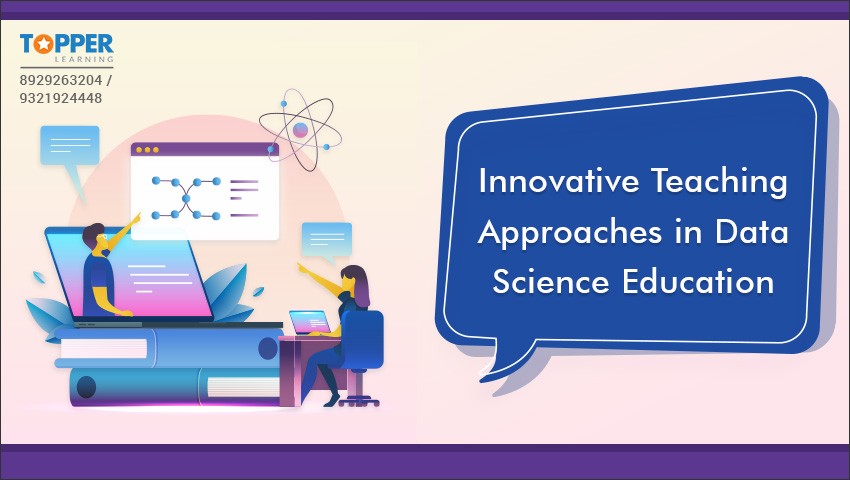Innovative Teaching Approaches in Data Science Education

Learn what data science is and how gap bridging, course organisation, and integration of computing and abstraction with minimal reliance on mathematics act as some of the major innovative teaching approaches in data science education.
By Topperlearning Expert 15th Jan, 2024 | 02:20 pm
ShareEducators face hurdles in teaching data science programs due to the field's interdisciplinary nature and the varying skills of students. Effective education in this area necessitates a holistic approach encompassing theory, practical skills, and industry applicability. Yet, finding teaching methods and tools that seamlessly merge these components is challenging. Thus, there's a necessity to pinpoint and create successful teaching methods, resources, and technological aids empowering instructors to provide comprehensive data science education, addressing students' diverse requirements and readying them for real-world data challenges.
What is Data Science?
Data science holds diverse meanings across contexts due to the varied requirements of data-centric businesses. These encompass data acquisition, management, processing, interpretation, communication of insights, and software development tailored for different purposes.
Innovative Teaching Approaches in Data Science Education
Some of the major teaching approaches towards data science education are:
Bridging the Gap
Enhancing traditional courses with mere data inclusion isn't enough. Merely introducing data doesn't automatically equip one with the skills to construct a robust curriculum. Just as a PhD in Statistics alone doesn't guarantee effective Data Science teaching, advocating for the involvement of experienced applied statisticians helps in connecting and computing in curriculum development. Practising data analysts from various fields can significantly enhance course development, bridging the gap between theory and practical application in Data Science education.
Organise the Course
The initial alteration in the standard statistical course for data science involved emphasising subject matter inquiries and treating statistical techniques and computing as instruments to address these queries. By focusing on problem-solving, students learn to link subject matter to statistical frameworks and acquire new statistical methods within the context of data analysis. You must prioritise the application of techniques as solutions to problems before delving into their mathematical intricacies, aiming to motivate and teach a broad spectrum of skills essential for success in the field of data science through carefully chosen diverse case studies.
Integrate Computing into Each Aspect
Recently, educational and scientific communities have embraced increased computing utilisation and mandated student assignments to be completed via programming. You must extend this practice to lectures within a data science course. This approach clarifies expectations for assignments, underscores the significance of computational abilities, and enhances hands-on data analysis experiences in the classroom.
Facilitate live coding and allow real-time data exploration, providing insights into an expert's decision-making regarding statistical techniques and computational tools.
Moreover, the use of literate programming results in reproducible research. In the classroom setting, this helps not only in student assignments and projects, fostering practical learning experiences, but also in lectures. Integrating data, code, and results into one document prevents students from spending considerable time outside class attempting to replicate analysis steps presented in lectures.
Teach Abstraction with Minimal Reliance on Mathematical Notation
Abstraction plays a crucial role in the statistical realm of data analysis, representing a significant contribution to the field. Emphasising the importance of developing a theoretical framework to comprehend experiences, you must learn from them and share insights with others. Despite deviating from the standard approach, you should consider abstraction fundamental in data science education and advocate its inclusion. This method steers away from heavy reliance on mathematical notation whenever possible. While mathematical notation offers an efficient means of describing statistical concepts, it often complicates the teaching of fundamental ideas. Therefore, you must opt for computational approaches, such as data visualisation or Monte Carlo simulations, to convey these concepts. By minimising mathematical notation, you encourage students to grasp concepts intuitively, fostering a deeper understanding of the subject matter.
Conclusion
Data science stands as a crucial asset for organisations aiming to enhance growth through a data-centric approach. Leveraging data science insights helps businesses to make informed decisions, streamline operations, and maintain competitiveness in an ever-evolving market. However, finding individuals equipped with the diverse skill set required is a complex task.
Beginning a career in this field requires a strong grasp of fundamentals and completion of courses from reputable institutes or online learning platforms.
At TopperLearning, we aim to prepare youngsters for these prospects by providing education on data science, artificial intelligence, and other essential skills aligned with the NEP 2020 plan, in sync with various board curriculums like ICSE, CBSE, and others. Let's embark on this exciting journey to explore the incredible possibilities inherent in these domains.
More from Education
Important Resources
- Education Franchisee opportunity
- NCERT Solution
- CBSE Class 9 Mathematics
- NCERT Solutions for class 10 Science
- Sample Papers
- CBSE Class 9 Science
- NCERT Solutions for class 10 Maths
- Revision Notes
- CBSE Class 10 Hindi
- CBSE Class 10 English
- CBSE Class 10 English
- CBSE Class 10 Social Studies
- CBSE Class 10 Science
- CBSE Class 10 Mathematics
- Career In Science After 10
- Career In Commerce After 10
- Career In Humanities/Arts After 10
- NCERT Solutions for Class 10
- NCERT Solutions for Class 11
- Business Studies Class 12 CBSE project





